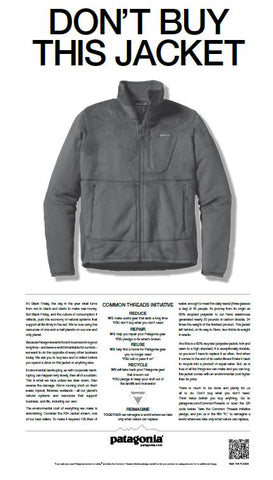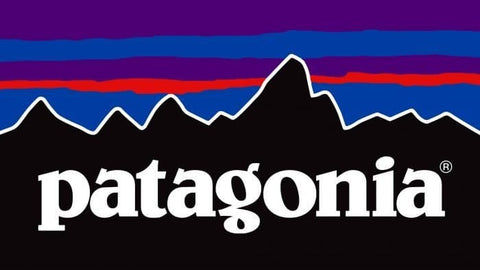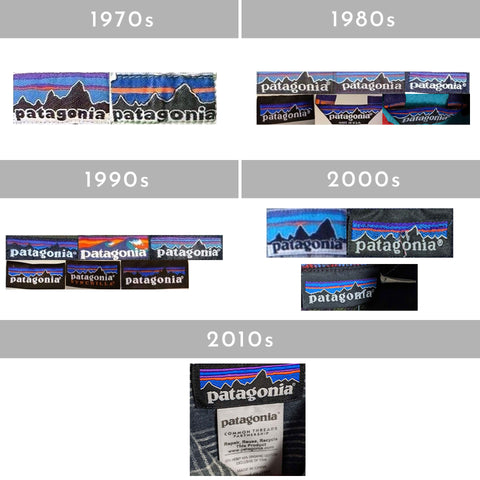How to tell if Patagonia is vintage
Patagonia, like many fashion brands, was born outside the realm of fashion. Founder Yvon Chouinard got started by selling climbing equipment that he personally designed and manufactured in 1965. As demand for his high quality climbing equipment grew, he found a partner to help expand production. The first Patagonia store opened in 1973 in Santa Clara, California under the name Great Pacific Iron Works. Patagonia expanded its range of products to cover a whole host of sporting and outdoor activities. Particularly popular was its apparel line, which was regarded as very durable and perfect for rugged activities. This strong reputation has helped it become popular within mainstream fashion, and items such as their Synchilla Fleece are highly sought after.
Patagonia has a powerful history of activism, and views itself as an activist company that should pursue strong ethical missions in society. One of its earliest examples of this is the 1985 pledge they took to donate 1% of total sales to environmental groups. Since then, they have publicly donated many of the windfalls the company has received, famously donating $10 million they received from Donald Trump’s tax cut to environmental groups. Recently they have pledged to become carbon neutral by 2025 and started to champion the circular economy and Patagonia resale market. They have even gone as far to create a marketplace to sell vintage Patagonia.
Other activism includes boycotting trade shows to impede legislation that puts national parks and wildlife at risk. They have also boycotted Facebook Advertising, explaining that they were unhappy with how little Facebook was doing to combat hate speech on the platform. It is also a leader in promoting worker safety and rights, carefully monitoring every step of the supply chain to ensure high standards. One of Patagonia’s most recent ethical stances was displayed in an advert that urged people not to buy a jacket, and instead focus on recycling clothes. Ironically this was one of the most successful marketing campaigns in the last few decades and skyrocketed sales and the brands reputation.

How to tell if Patagonia is vintage from the logo
The name Patagonia is a reference to an area in South America spread across Argentina and Chile. The silhouette visible in the background of Patagonia logos is an outline of Monte Fitz Roy, a mountain on the Argentine and Chile border. The font overlay is Belwe Bold. Due to Patagonia being a relatively young company the logo has essentially not changed since its launch in 1973. This means the logo does not give us much in the way of determining the age of vintage Patagonia. A few different iterations have been used on marketing materials, but the main, coloured logo is used on the majority of products.



How to tell if Patagonia is vintage from the tags
Patagonia prides itself on using the highest quality, and most ethically sourced materials. Activist groups have uncovered potentially dubious practices in the supply chain, such as the use of force fed geese feathers for down and the use of poorly sheared wool. In both cases the company responded in a strong manner, quickly aiming to fix and monitor these areas.
A few rules can be applied to start narrowing down whether or not Patagonia is vintage. Firstly, Patagonia only began manufacturing outside the USA after 2012. So, if your Patagonia was made outside the USA, it likely isn’t vintage. However, Patagonia does still manufacture some items in the USA, so just because something was made there, it doesn’t necessarily mean that it’s vintage. And secondly, extra white tags attached to the main tag usually indicate that the item is from the mid 2000s onwards.
Thirdly, the buttons on vintage Patagonia items tended to be smaller and made of a slightly more metallic material. However just because an item has the newer, bigger buttons, it doesn’t mean the item isn’t vintage because Patagonia offers a lifetime repair service where their customers take in damaged Patagonia items that they then repair free of charge, sometimes with new parts. Another clue to look out for with the buttons is how many are on the item. This is only really applicable for fleeces, but when a fleece has three buttons, it is a sure fire sign that your Patagonia is vintage. Other than that, direct comparisons between example tags are a great way to determine an answer. Because of such subtle changes to tags over the years, its important to compare minor details such as the thickness of the font, the exact outline of the mountain range and the colour scheme used. But if you're still struggling to figure it out after looking at the tags below, you can submit your tags here for us to have a look at and try and investigate.
1970s vintage Patagonia tags
- Like most tags from the 70s, these Patagonia tags are generally lower in quality
- They are white fabric rectangles
- They use the legacy emblem and logo
- The text has a white outline around it
- Tags from this time were also fully sewn in all the way round
- No information other than the brand was included on these tags

1980s vintage Patagonia tags
- The shape of the tags became longer in the 1980s, and the loop tag was introduced
- The usual emblem and logo is used
- The font is slightly thicker than previous iterations and no longer has an outline, instead it is white
- A few of these tags included the country of manufacture information, but mostly they only included the brand logo

1990s vintage Patagonia tags
- The main features of these tags remained very similar, with subtle changes to the background and font thickness and placement, carefully observe these to compare tags
- The Patagonia Synchilla was introduced in the 1990s, and this is an example of its original label
- To appeal to its growing surfer market, it also created a limited edition tag that used a background of waves instead of mountains
- More of the tags became tabs instead of being completely sewn in

2000s vintage Patagonia tags
- This transition was probably Patagonia’s biggest change in recent times, with the logo becoming a smaller feature on a bigger tag
- A remake of an older tag with the white background was created, with the white outline around the text
- The more common black tag would sometimes be accompanied by a white tag to its left that included sizing and care information


2010s vintage Patagonia tags
- Many of the tags from this era are completely sewn in, and have a white tag attached to them with more information about the item
- Due to its global deals for mass production, the logo and emblem became more consistent, with fewer subtle variations between tags

Vintage Patagonia tags through the years - The History of Patagonia tags

How to tell if Patagonia is vintage from the product code and wash tags
A final method that can help find an exact date of production is reading the product code on tags behind the wash tags. Whist this is an incredibly useful method as it is so precise, a flaw is that many vintage Patagonia items have seen so much wear that the information has washed off the tags over the years. So hopefully if this doesn’t work for you, you can use the above methods to triangulate whether or not your Patagonia is vintage.
So, for Patagonia product codes, look for the two letters follow by a number. As you can see in the example below, the style code ends in ‘FA16’. This means that it was created in the Fall Autumn season of 2016. The example below that has the code of SP7. This means it was created in the Spring Summer season of 1997.


